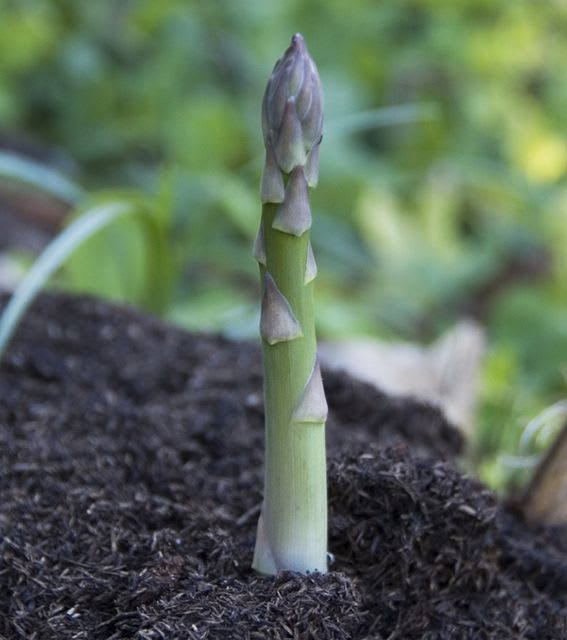Late winter/early spring is the time of year to plant asparagus crowns. A few years ago I bought some, planted them following instructions, but often felt that I had no idea how to treat these plants. When do you cut the spears? What maintenance do they need? Should you only get male asparagus? A few weeks ago I finally decided to find out. Here is what I found.Overview
First cultivated by the ancient Greeks, asparagus is a member of the lily family, originating from eastern Mediterranean coastal areas. Its shoots (called spears) come in green, white or purple, but that does not mean there are three asparagus varieties. White asparagus, a sought-after delicacy in Europe, is simply green asparagus grown in the dark. Purple asparagus, on the other hand, is a separate variety described as sweeter and softer.
Growing asparagus is a worthwhile long-term project that provides little return in the first few years, but that can produce a delicious crop for the two decades thereafter.
What to buy if you want to grow asparagus?
Some people buy asparagus seeds. Sow the seeds in a seed tray with large individual sections, keep watered and they will come up, because asparagus seeds easily germinate. But in their first year they won't look like the photo below. Keep the small seedlings in the tray for the first year or plant them out in nice tasty soil, look after them and at the end of Year 1 the foliage will die off and leave you with what most people buy, that is one year old root systems called crowns.
The advantage of buying crowns over seed is that you have gained a year, but crowns are a lot more expensive than seed. If you buy crowns, make sure that they are fresh and firm. Plant them immediately if possible, or wrap them in slightly damps sphagnum moss until you can do so.

Why the focus on male/female?
Asparagus plants are either male or female. Both male and female plants flower when they are mature, but from there on female plants focus on producing seed, whereas male plants use all that energy to produce spears. The result is that male plants have much thicker spears than female plants.
The big question for most people growing asparagus is therefore, “How do I make sure all my plants are male?” The answer to that question is not so easy.
The seeds all look the same. The crowns all look the same. Some suggest you buy the fattest crowns if you have the choice, but there is no guarantee. You may also not see much difference when spears come up in the first year. Stalks may be thin because the crown is still establishing itself.
You really only know for certain that an asparagus plant is female when the mature plant produces seeds, that are green at first, and then turn red in autumn, and that may be in Year 3 of the life of the plant. By the way, these berries are poisonous.
For home growers it may not matter much if some spears are a bit thinner and somewhat lower quality than others, but commercial growers cannot afford to find at the end of Year 3 that half their plants are female. This is why for many centuries seed-cultivators have tried to create asparagus varieties that produce many more male than female plants, with considerable success.
High-yielding hybrids such as Jersey Knight and Jersey Giant produce a high percentage of male plants. However, it is likely that some of the old-fashioned heirloom varieties such as Mary Washington have a better taste.
Planting asparagus
Carefully choose where your asparagus plants are going to be, because ideally they will be in that spot for at least the next 15 years. You can move mature asparagus crowns in mid-winter, but this will diminish yield for at least the following season.
Asparagus is a heavy feeder that likes a sunny position in rich, non-clay, well-drained deep soil. A raised bed with plenty of compost is an ideal environment.
Recommended pH is 6.5 to 7.5, so that is higher than many other food garden crops. It is because asparagus originally came from a maritime environment.
Plant asparagus plants late winter to early spring, before growth occurs from the crown. Dig a hole about 15cm deep. Place a small mound of earth in the hole, then set the plant on the mound so that the roots hang down and are evenly spread out in the hole. Cover the crown with 5cm of topsoil and water well to get rid of air pockets. As spears begin to form, add more and more soil until the hole is completely filled. The top of the crown should be 10 to 13cm below the soil surface.
Between-row spacing should be around 80cms, in-row spacing around 40cms.
If your aim is to produce white asparagus, start with a deeper trench (about 20cm deep) and keep adding soil on top, making sure that all the time just the tips of spears are above soil level.

When to cut spears
Year 1: the plant grows from seed and forms a crown. During the year you do not cut any foliage because the foliage feeds the crown and you want a strong crown to develop. At the end of Year 1 the foliage dies, you cut it off, dig up the crown and plant it in its permanent position.
Year 2: spears will come up, get branches and fern-like foliage will form, same as in Year 1, but taller and thicker. If you cut spears this year you decrease the growth of the crown or, worse, cause stress. That happened with one of mine and it died.
Year 3: in spring harvest one spear per plant (if you can't stop yourself) and let the rest grow. Stalks can become 1.5 metre high.
Year 4: Finally, a full cutting season of six to 10 weeks is permitted. Pick regularly to encourage and increase growth of new spears. After the cutting season allow foliage to form, so the crown can be fed and grow.
Years 5-20: look after your plants (see below) and you can cut spears for a full six to 10 weeks every year for many years to come. Asparagus reaches its prime after six to eight years.
It has been reported that in optimum warm conditions spear growth rates can approach 1cm per hour. That may not happen in Tasmania, but it is still prudent to watch spears as they progress. It is not worth cutting a spear once its tip has opened.

How to cut spears
Cut a spear when it is 1-2cm in diameter and 15-20cm long and before its tip opens up. Cutting is best done with a sharp knife at ground level. For a slightly longer spear push the knife into the ground so that it severs the spear about 2 cms below ground, but make sure you do not cut young spears that have not yet emerged above ground.
Maintenance
Throughout the year keep your asparagus patch weed-free and support foliage with stakes.
For best performance keep soil moist, but not sodden, at all times.
Asparagus plants go into a dormancy period over winter. At the start of this foliage goes yellow and can be cut off at ground level.
In mid-winter add compost, a complete organic fertiliser and mulch to give the crown plenty of food to produce new spears in spring.
Asparagus is not particularly prone to pests and diseases.
Be patient with your asparagus plants and you will have a nutritious, delicious crop each year. Asparagus is high in potassium, calcium, iron and Vitamin C. There is nothing nicer than growing your own and having it fresh from the garden.
Max Bahrfeldt started The Food Garden Group a decade ago after retiring from many years of full-time teaching, managing and designing courses for adult education. The aim of the group is to create an active community of Tasmanian food gardeners, who freely share their knowledge, surplus produce, seeds and plants. Meeting other food gardeners face to face is an important part of the group, and through this many food gardeners have found new friends with like-minded interests. Members include beginners, experienced food gardeners, and some horticultural professionals.
This article first appeared on The Food Garden Group blog (foodgardengroup.blogspot.com).








